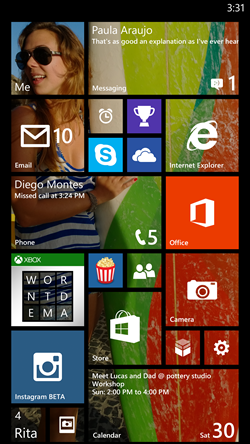
Microsoft Corporation is an American multinational corporation and technology company headquartered in Redmond, Washington. Its best-known software products are the Windows line of operating systems, the Microsoft 365 suite of productivity applications, the Azure cloud computing platform and the Edge web browser. Its flagship hardware products are the Xbox video game consoles and the Microsoft Surface lineup of touchscreen personal computers. Microsoft ranked No. 14 in the 2022 Fortune 500 rankings of the largest United States corporations by total revenue; and it was the world's largest software maker by revenue in 2022 according to Forbes Global 2000. It is considered one of the Big Five American information technology companies, alongside Alphabet, Amazon, Apple, and Meta.

Steven Anthony Ballmer is an American businessman and investor who was the chief executive officer of Microsoft from 2000 to 2014. He is the owner of the Los Angeles Clippers of the National Basketball Association (NBA). He is a co-founder of Ballmer Group, a philanthropic investment company.
Microsoft is a multinational computer technology corporation. Microsoft was founded on April 4, 1975, by Bill Gates and Paul Allen in Albuquerque, New Mexico. Its current best-selling products are the Microsoft Windows operating system; Microsoft Office, a suite of productivity software; Xbox, a line of entertainment of games, music, and video; Bing, a line of search engines; and Microsoft Azure, a cloud services platform.

Jefferson Y. "Jeff" Han is a computer scientist who worked for New York University's (NYU) Courant Institute of Mathematical Sciences until 2006. He is one of the main developers of "multi-touch sensing", which, unlike older touch-screen interfaces, is able to recognize multiple points of contact.

In computing, multi-touch is technology that enables a surface to recognize the presence of more than one point of contact with the surface at the same time. The origins of multitouch began at CERN, MIT, University of Toronto, Carnegie Mellon University and Bell Labs in the 1970s. CERN started using multi-touch screens as early as 1976 for the controls of the Super Proton Synchrotron. Capacitive multi-touch displays were popularized by Apple's iPhone in 2007. Multi-touch may be used to implement additional functionality, such as pinch to zoom or to activate certain subroutines attached to predefined gestures using gesture recognition.

Microsoft PixelSense was an interactive surface computing platform that allowed one or more people to use and touch real-world objects, and share digital content at the same time. The PixelSense platform consists of software and hardware products that combine vision based multitouch PC hardware, 360-degree multiuser application design, and Windows software to create a natural user interface (NUI).
FingerWorks was a gesture recognition company based in the United States, known mainly for its TouchStream multi-touch keyboard. Founded by John Elias and Wayne Westerman of the University of Delaware in 1998, it produced a line of multi-touch products including the iGesture Pad and the TouchStream keyboard, which were particularly helpful for people suffering from RSI and other medical conditions. The keyboards became the basis for the iPhone's touchscreen when the company's assets were acquired by Apple Inc. in early 2005.

Windows Phone (WP) is a discontinued mobile operating system developed by Microsoft Mobile for smartphones as the replacement successor to Windows Mobile and Zune. Windows Phone featured a new user interface derived from the Metro design language. Unlike Windows Mobile, it was primarily aimed at the consumer market rather than the enterprise market.
The Multi-Touch Collaboration Wall is a large monitor invented by Jeff Han that employs multi-touch technology, and is marketed by Han's company, Perceptive Pixel. Han initially developed the technology for military applications. The wall has received most of its publicity because of its use by news network CNN during its coverage of the 2008 US presidential election. Usually operated by John King, it is often referred to as CNN's "Magic Wall", or the "Magic Map."
In computing, a natural user interface (NUI) or natural interface is a user interface that is effectively invisible, and remains invisible as the user continuously learns increasingly complex interactions. The word "natural" is used because most computer interfaces use artificial control devices whose operation has to be learned. Examples include voice assistants, such as Alexa and Siri, touch and multitouch interactions on today's mobile phones and tablets, but also touch interfaces invisibly integrated into the textiles furnitures.

Windows Mobile 6.5 is a version of Windows Mobile. It was a stopgap update to Windows Mobile 6.1 intended to bridge the gap between version 6.1, that arrived in 2008, and Windows Phone 7 that was released in 2010.

The DiamondTouch table is a multi-touch, interactive PC interface product from Circle Twelve Inc. It is a human interface device that has the capability of allowing multiple people to interact simultaneously while identifying which person is touching where. The technology was originally developed at Mitsubishi Electric Research Laboratories (MERL) in 2001 and later licensed to Circle Twelve Inc in 2008. The DiamondTouch table is used to facilitate face-to-face collaboration, brainstorming, and decision-making, and users include construction management company Parsons Brinckerhoff, the Methodist Hospital, and the US National Geospatial-Intelligence Agency (NGA).

Ideum is a company based in Corrales, New Mexico, United States that produces multitouch tables and walls, custom interactive exhibits, and custom hardware. The company was founded in 1999 by Jim Spadaccini, who created interactive exhibits for San Francisco's Exploratorium before becoming creative director at Ideum. With strong ties to the museum and informal science education fields, many of the company's products and services are targeted at museums and other public spaces. In 2015 and 2016, the company was listed on the Inc. 5000, list of the Fastest Growing Companies in the US. In 2017 and again in 2018, the company was honored as one of the "Best Entrepreneurial Companies in America" by Entrepreneur Magazine.

The MT-50 is an interactive multi-touch table developed by Ideum. The table, now retired, had a 50" display with a 1280 x 720 resolution that used IR flood technology to register multi-user, multitouch gestures, and used the NUI Snowflake software package to handle optical processing. It supported over 50 discrete touch points. The casing was built with aircraft-grade aluminum and tempered glass to allow it to stand heavy use in public environments.
The history of tablet computers and the associated special operating software is an example of pen computing technology, and thus the development of tablets has deep historical roots. The first patent for a system that recognized handwritten characters by analyzing the handwriting motion was granted in 1914. The first publicly demonstrated system using a tablet and handwriting recognition instead of a keyboard for working with a modern digital computer dates to 1956.

Microsoft Tablet PC is a term coined by Microsoft for tablet computers conforming to hardware specifications, devised by Microsoft, and announced in 2001 for a pen-enabled personal computer and running a licensed copy of the Windows XP Tablet PC Edition operating system or a derivative thereof.

Microsoft Surface is a series of touchscreen-based personal computers, tablets, and interactive whiteboards designed and developed by Microsoft, most of them running the Windows operating system. They are designed to be premium devices that set examples for manufacturers of other Windows-compatible products. It comprises several generations of hybrid tablets, 2-in-1 detachable notebooks, a convertible desktop all-in-one, an interactive whiteboard, and various accessories, many with unique form factors. The majority of devices in the Surface lineup are based on Intel processors and compatible with Windows 10 or Windows 11.
The Lenovo Miix was a series of multi-mode computing devices that function as both a tablet and a notebook computer.

The Surface Hub is a brand of interactive whiteboard developed and marketed by Microsoft, as part of the Microsoft Surface family. The Surface Hub is a wall-mounted or roller-stand-mounted device with either a 55-inch (140 cm) 1080p or an 84-inch (210 cm) 4K 120 Hz touchscreen with multi-touch and multi-pen capabilities, running the Windows 10 operating system. The devices are targeted for businesses to use while collaborating and videoconferencing.
Microsoft, a technology company historically known for its opposition to the open source software paradigm, turned to embrace the approach in the 2010s. From the 1970s through 2000s under CEOs Bill Gates and Steve Ballmer, Microsoft viewed the community creation and sharing of communal code, later to be known as free and open source software, as a threat to its business, and both executives spoke negatively against it. In the 2010s, as the industry turned towards cloud, embedded, and mobile computing—technologies powered by open source advances—CEO Satya Nadella led Microsoft towards open source adoption although Microsoft's traditional Windows business continued to grow throughout this period generating revenues of 26.8 billion in the third quarter of 2018, while Microsoft's Azure cloud revenues nearly doubled.










